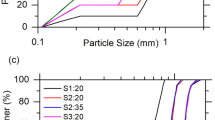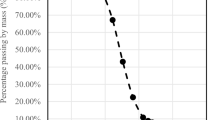Abstract
A nonlinear multi-field coupled model for multi-constituent three-phase soils is derived by using the hybrid mixture theory. The balance equations with three levels (constituents, phases and the whole mixture soil) are set up under the assumption that soil is composed of multi-constituent elastic-plastic solid skeleton (which is different from the linearization method) and viscous liquid and ideal gas. With reasonable constitutive assumptions in such restrictive conditions as the principles of determinism, equipresence, material frame-indifference and the compatible principle in continuum mechanics, a theoretical framework of constitutive relations modeling three-phase soil in both non-equilibrium and equilibrium states is established, thus the closed field equations are formed. In the theoretical framework, the concept of effective generalized thermodynamic forces is introduced, and the nonlinear coupling constitutive relations between generalized dissipation forces and generalized flows within the system at nonequilibrium state are also presented. On such a basis, four special coupling relations, i.e., solid thermal elastic-plastic constitutive relation, liquid visco-elastic-plastic constitutive relation, the generalized Fourier’s law, and the generalized Darcy’s law are put forward. The generalized or nonlinear results mentioned above can degenerate into the linear coupling results given by Bennethum and Singh. Based on a specific dissipation function, the concrete form of generalized Darcy’s law is deduced, which may degenerate into the traditional form of Darcy’s law by neglecting the influence of skeleton deformation and temperature. Without considering temperature and other coupling effects, the nonlinear coupled model in this paper can degenerate into a soil elastic-plastic constitutive model.
Similar content being viewed by others
References
Zhao C G, Liu Y. Continuum porous medium soil mechanics and its application in constitutive relationship of unsaturated soils. Chin J Geotech Eng, 2009, 31: 1324–1335
Truesdell C. Rational Thermodynamics. 2nd ed. New York: Springer-Verlag, 1984
Bowen R M. Incompressible porous media models by use of the theory of mixtures. Int J Eng Sci, 1980, 18: 1129–1148
Bowen R M. Compressible porous media models by use of the theory of mixtures. Int J Eng Sci, 1982, 20: 697–735
de Boer R. Highlights in the historical development of the porous media: Toward a consistent macroscopic theory. Appl Mech Rev, 1996, 49: 201–262
Hassanizadeh S M, Gray W G. General conservation equations for multiphase systems: 1. Averaging procedure. Adv Water Resour, 1979, 2: 131–144
Hassanizadeh S M, Gray W G. General conservation equations for multiphase systems: 2. Mass, momenta, energy, and entropy equations. Adv Water Resour, 1979, 2: 191–208
Hassanizadeh S M, Gray W G. General conservation equations for multiphase systems: 3: constitutive theory for porous media. Adv Water Resour, 1980, 3: 25–40
Achanta S, Cushman J H. On multiconstituent, multiphase thermomechanics with interfaces. Int J Eng Sci, 1994, 32: 1717–1738
Morland L W. A simple constitutive theory for a fluid-saturated porous solid. J Geophys Res, 1972, 77: 890–900
Goodman M A, Cowin S C. A continuum theory for granular materials. Arch Rational Mech Anal, 1972, 44: 249–266
Passman S L, Nunziato J W, Walsh E K. A theory of multiphase mixtures. In: Truesdell C, ed. Rational Thermodynamics. New York: Springer-Verlag, 1984. 286–325
Svendsen B, Hutter K. On the thermodynamics of a mixture of isotropic materials with constraints. Int J Engng Sci, 1995, 33: 2021–2054
Hutter K, Laloui L, Vulliet L. Thermodynamically based mixture models of saturated and unsaturated soils. Mech Cohes-Frict Mater, 1999, 4: 295–338
Hassanizadeh S M. Derivation of basic equations of mass transport in porous media, Part 1. Macroscopic balance laws. Adv Water Resour, 1986, 9: 196–206
Hassanizadeh S M. Derivation of basic equations of mass transport in porous media, Part 2. Generalized darcy’s and fick’s law. Adv Water Resour, 1986, 9: 207–222
Bennethum L S, Cushman J H. Multiscale, hybrid mixture theory for swelling systems-I: balance laws. Int J Eng Sci, 1996, 34: 125–145
Bennethum L S, Cushman J H. Multiscale, hybrid mixture theory for swelling systems-II: constitutive theory. Int J Eng Sci, 1996, 34: 147–169
Bennethum L S, Murad M A, Cushman J H. Macroscale thermodynamics and the chemical potential for swelling porous media. Transp Porous Med, 2000, 39: 187–225
Huang L, Zhao C G. A micropolar mixture theory of multi-constituent porous media. Appl Math Mech, 2009, 30: 617–630
Coleman B D, Noll W. The thermodynamics of elastic materials with heat conduction and viscosity. Archiv Rational Mech Anal, 1963, 13: 167–178
Olivella S, Carrera J, Gens A, et al. Nonisothermal multiphase flow of brine and gas through saline media. Transp Porous Med, 1994, 15: 271–293
Olivella S, Carrera J, Gens A, et al. Porosity variations in saline media caused by temperature gradients coupled to multiphase flow and dissolution/precipitation. Transp Porous Med, 1996, 25: 1–25
Zhao C G, Zhang X D. Derivation of the work expression and discussion on the effective principle and the phase separation theorem in unsaturated soil. Sci China Ser E-Tech Sci, 2008, 51: 1530–1541
Li X S. Thermodynamics-based constitutive framework for unsaturated soils. 1: Theory. Géotechnique, 2007, 57: 411–422
Li X S. Thermodynamics-based constitutive framework for unsaturated soils. 2: A basic triaxial model. Géotechnique, 2007, 57: 423–435
Singh P P, Cushman J H, Maier D E. Three scale thermomechanical theory for swelling biopolymeric systems. Chem Eng Sci, 2003, 58: 4017–4035
Collins I F, Kelly P A. A thermomechanical analysis of a family of soil models. Géotechnique, 2002, 52: 507–518
Jussila P. Thermomechanics of porous media-I: thermohydraulic model for compacted bentonite. Transp Porous Med, 2006, 62: 81–107
Jussila P, Ruokolainen J. Thermomechanics of porous media-II: thermo-hydro-mechanical model for compacted bentonite. Transp Porous Med, 2007, 67: 275–296
Author information
Authors and Affiliations
Corresponding author
Rights and permissions
About this article
Cite this article
Cai, G., Zhao, C., Liu, Y. et al. A nonlinear multi-field coupled model for soils. Sci. China Technol. Sci. 54, 1300–1314 (2011). https://doi.org/10.1007/s11431-011-4307-2
Received:
Accepted:
Published:
Issue Date:
DOI: https://doi.org/10.1007/s11431-011-4307-2




